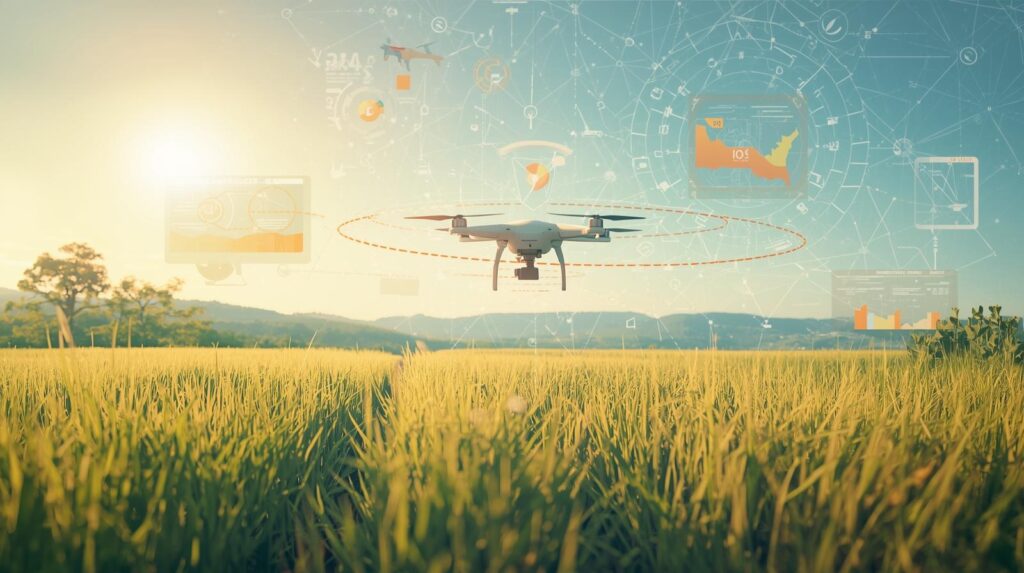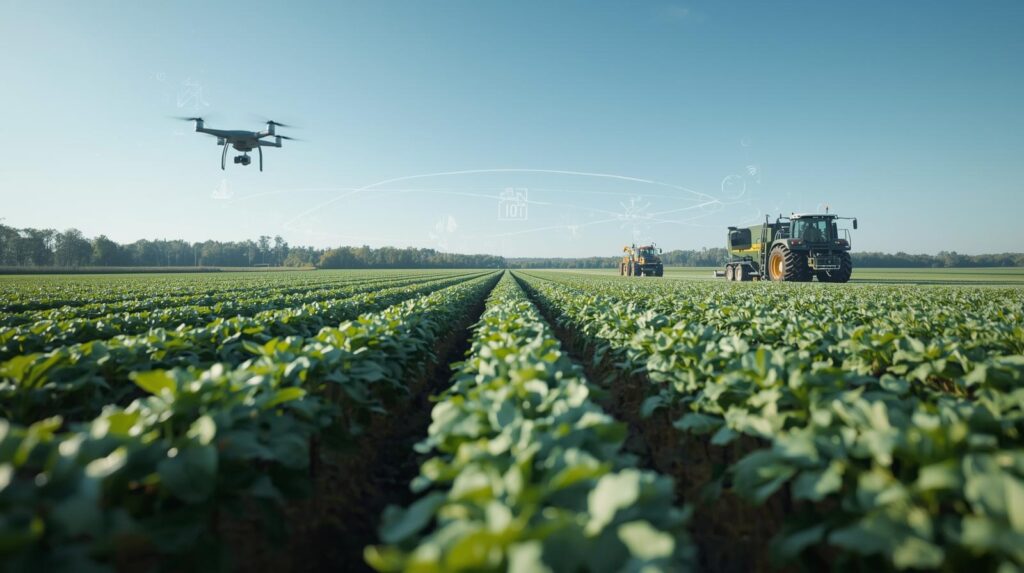The agricultural sector is undergoing a profound transformation, shifting from a reliance on intuition and tradition to a data-driven, precision-oriented science. At the heart of this revolution is the Internet of Things (IoT), a network of interconnected devices that collect, transmit, and analyze data. The integration of IoT in agriculture, often termed Smart Farming or Precision Agriculture, is not merely an incremental improvement; it is a fundamental rewrite of the rules of cultivation and livestock management. This article delves deep into the Global Trends in Agriculture IoT, exploring the technologies, applications, and future directions that are shaping the future of our food systems. From sensors in the soil to satellites in the sky, a new era of connected intelligence is enabling farmers to produce more with less, ensuring sustainability and food security for a growing global population.
The global Agriculture IoT Market size was estimated at USD 8.50 billion in 2024 and is predicted to increase from USD 8.86 billion in 2025 to approximately USD 12.61 billion in 2030, expanding at a CAGR of 7.3% from 2025 to 2030.

The Foundation of Agricultural IoT
At its core, Agricultural IoT is built upon a simple yet powerful cycle: sense, transmit, analyze, and act. A myriad of sensors deployed across fields and farms act as the digital eyes and ears, gathering critical data on a vast range of parameters. This data is then transmitted via various communication protocols like LoRaWAN, Zigbee, or cellular networks to a central platform. Powerful algorithms and artificial intelligence then analyze this immense volume of information, transforming raw data into actionable insights. Finally, these insights enable automated actions or informed decisions, such as triggering irrigation systems, applying precise amounts of fertilizer, or alerting a farmer to a sick animal. This closed-loop system minimizes waste, optimizes resources, and maximizes output, addressing some of the most pressing challenges in modern agriculture.
Key Drivers Behind the Adoption of IoT
Several powerful forces are converging to accelerate the adoption of IoT technologies in agriculture. The relentless growth of the global population is pushing demand for food to unprecedented levels, necessitating a significant increase in productivity. Concurrently, climate change is introducing new volatilities, with unpredictable weather patterns, droughts, and pests threatening traditional farming models. There is also a growing scarcity of resources, particularly water and arable land, and a rising consumer demand for transparency and sustainably produced food. Furthermore, the chronic labor shortages experienced in many agricultural regions make automation not just preferable, but essential. IoT presents a viable solution to all these challenges, making it one of the most critical technological investments for the future of farming.
Precision Farming and Crop Management
Precision farming is arguably the most significant application and a major trend within the Global Trends in Agriculture IoT. It moves away from the one-size-fits-all approach to field management, instead treating different areas of a field according to their specific needs. IoT enables this through:
- Soil Monitoring: Probes and sensors measure moisture levels, temperature, nutrient content (NPK), and pH in real-time, allowing for hyper-localized irrigation and fertilization.
- Variable Rate Technology (VRT): This technology uses data from soil scans, GPS, and yield maps to automatically adjust the amount of seeds, water, and fertilizers applied by machinery as it moves across the field.
- Micro-Climate Monitoring: On-field weather stations provide hyper-local data on rainfall, humidity, wind speed, and solar radiation, enabling better prediction of disease outbreaks and optimal harvesting times.
Livestock Monitoring and Management
The benefits of IoT extend beyond crops into livestock farming. Connected devices are revolutionizing animal husbandry by providing continuous, individual monitoring that was previously impossible. Smart collars and ear tags equipped with sensors track a wealth of data including location, activity levels, temperature, and feeding patterns. This data is analyzed to detect illnesses early, often before visible symptoms appear, allowing for prompt treatment and preventing the spread of disease.
Agricultural Drones and UAVs
Unmanned Aerial Vehicles (UAVs), or drones, have become indispensable tools in the smart farmer’s arsenal. They offer a versatile and efficient platform for capturing high-resolution data from above. Equipped with multispectral, hyperspectral, and thermal cameras, drones can generate detailed maps that reveal issues invisible to the naked eye. They can identify areas of plant stress, detect pest infestations, assess crop health through NDVI (Normalized Difference Vegetation Index) maps, and monitor irrigation systems for leaks. Beyond sensing, advanced drones are now capable of performing precise actions, such as spraying pesticides or fertilizers in targeted zones, drastically reducing chemical usage and protecting the health of farmers by minimizing exposure.
Smart Greenhouses and Controlled Environment Agriculture
IoT technology is enabling the automation and optimization of greenhouses and indoor farming facilities, a sector known as Controlled Environment Agriculture (CEA). Traditional manual control is replaced by a network of sensors that continuously monitor and adjust climate conditions—light intensity, temperature, humidity, CO2 levels, and nutrient concentration in hydroponic systems. This data feeds into a central climate control system that automates windows, shades, heaters, and coolers to maintain the perfect environment for plant growth 24/7. This trend allows for year-round production of high-value crops irrespective of external weather, eliminates pesticide use, and reduces water consumption by up to 90% compared to traditional open-field farming.
AI and Big Data Analytics in Agriculture
The true potential of IoT is unlocked only when the massive amounts of data generated by sensors—often called Big Data—are effectively analyzed. This is where Artificial Intelligence (AI) and Machine Learning (ML) come into play. These technologies are a cornerstone of the Global Trends in Agriculture IoT, moving beyond simple monitoring to predictive and prescriptive analytics. AI algorithms can predict crop yields with remarkable accuracy, forecast optimal planting and harvesting dates, and diagnose crop diseases from images captured by smartphones or drones. They can analyze historical and real-time data to provide prescriptive recommendations on what actions a farmer should take to mitigate risks and improve outcomes, transforming raw data into wisdom.
Automation and Robotics
The logical culmination of sensing and analysis is automated action. Robotics is rapidly moving from concept to reality in modern agriculture. Autonomous tractors and robotic harvesters are being deployed to perform tasks like planting, weeding, and picking with superhuman precision and endurance. These machines use computer vision and AI to identify weeds and spray them individually or mechanically remove them, enabling organic farming at scale. Robotic harvesters equipped with advanced grippers can pick delicate fruits like strawberries and apples without bruising, solving critical labor shortage problems. This trend towards automation is making farming less labor-intensive, more efficient, and more precise.

Challenges and Barriers to Adoption
Despite its immense potential, the widespread adoption of Agricultural IoT faces several significant hurdles. The initial investment cost for sensors, hardware, and software platforms can be prohibitive for smallholder farmers, creating a digital divide. The reliability of connectivity in often-remote rural areas remains a major technical challenge. There are also concerns regarding data privacy, ownership, and cybersecurity, as farms become increasingly digitized. Furthermore, a skills gap exists; farmers need training to effectively interpret data and manage these complex digital systems. Overcoming these barriers requires collaborative efforts from technology providers, governments, and agricultural cooperatives to develop affordable, user-friendly, and secure solutions.
Download PDF Brochure @ https://www.marketsandmarkets.com/pdfdownloadNew.asp?id=199564903
The Future of Agriculture IoT
The future trajectory of Global Trends in Agriculture IoT points towards even greater integration and intelligence. We are moving towards the development of fully autonomous, closed-loop farms where decisions are made and executed by AI with minimal human intervention. The integration of blockchain technology with IoT will provide immutable traceability from farm to fork, giving consumers unparalleled transparency. swarm robotics, where multiple smaller robots work in coordination, will become more prevalent. Furthermore, as connectivity improves with the rollout of 5G and satellite internet (like Starlink), even the most remote farms will be able to participate in the digital agricultural revolution, creating a truly global network of smart farms.
Conclusion
The Global Trends in Agriculture IoT represent a paradigm shift in one of humanity’s oldest industries. By weaving a digital nervous system across farms and fields, IoT is empowering farmers to achieve unprecedented levels of efficiency, productivity, and sustainability. It is a powerful response to the intertwined challenges of population growth, climate change, and resource scarcity. While challenges related to cost, connectivity, and skills remain, the momentum is undeniable. As technology continues to advance and become more accessible, the vision of a connected, intelligent, and sustainable agricultural system is steadily becoming a reality, promising a more food-secure and resilient future for all.
Explore In-Depth Semiconductor & Electronics Market Research:
https://www.marketsandmarkets.com/semiconductorand-electonics-market-research-87.html
FAQs
1. What exactly is Agriculture IoT?
Agriculture IoT refers to the use of interconnected sensors, devices, and software in farming. These technologies collect and analyze data on crops, livestock, soil, and climate to help farmers monitor, automate, and optimize operations for better yields and efficiency.
2. How does IoT help in improving crop yields?
IoT improves yields through precision farming. Sensors provide real-time data on soil moisture and nutrients, allowing for precise watering and fertilization. Drones and satellites identify stressed plants early, and AI predicts optimal harvest times, all contributing to healthier crops and higher production.
3. Is Agriculture IoT only for large-scale farms?
While early adoption was led by large enterprises, the technology is becoming increasingly affordable and scalable. Solutions are now being developed for small and mid-sized farms, including subscription-based models and cooperatives that share resources, making IoT accessible to a wider range of farmers.
4. What is the biggest challenge for implementing IoT in agriculture?
The primary challenges are the high initial investment cost and the need for reliable internet connectivity in rural areas. Other significant barriers include data security concerns and the need for digital literacy and training among farmers to use these advanced systems effectively.
5. How does IoT contribute to sustainable farming practices?
IoT promotes sustainability by enabling the precise application of water, fertilizers, and pesticides, drastically reducing runoff and environmental impact. It optimizes resource use, helps monitor soil health, and supports practices that can reduce a farm’s carbon footprint, contributing to more eco-friendly agriculture.
See The Latest Semiconductor Reports:
Quantum Computing Market Size, Share & Trends : https://www.marketsandmarkets.com/Market-Reports/quantum-computing-market-14